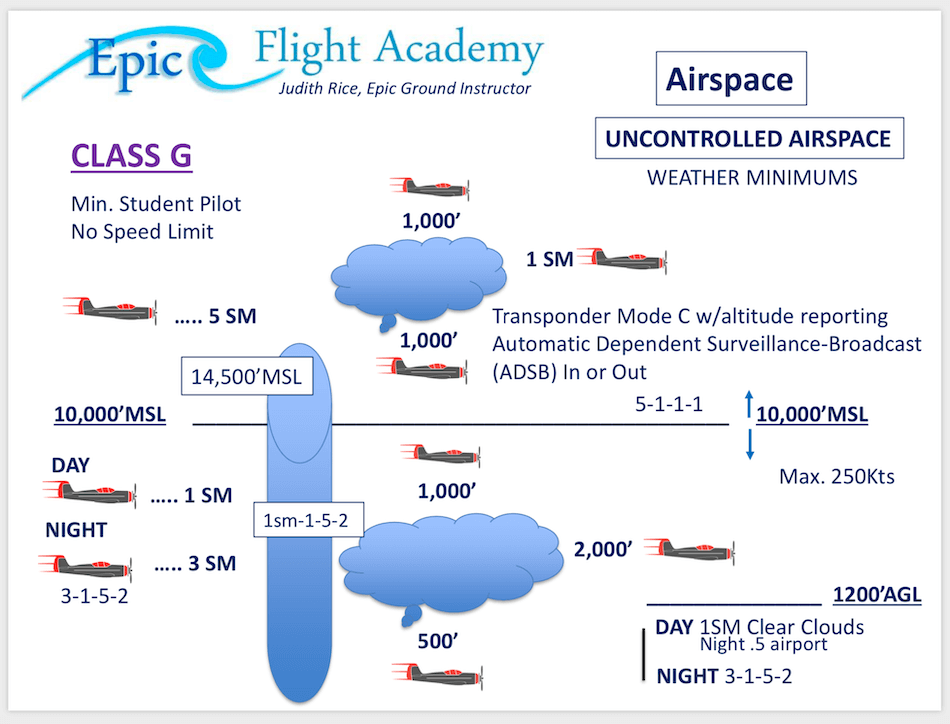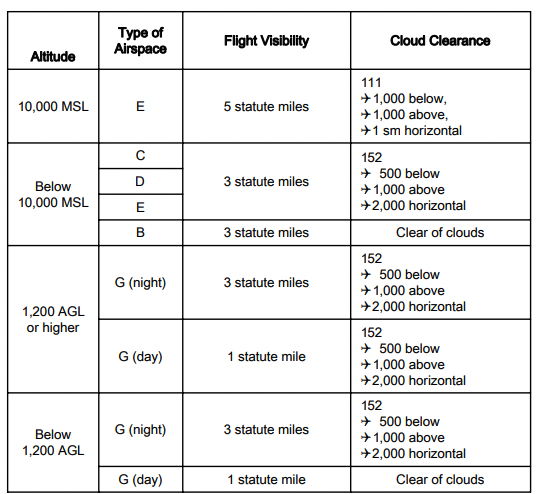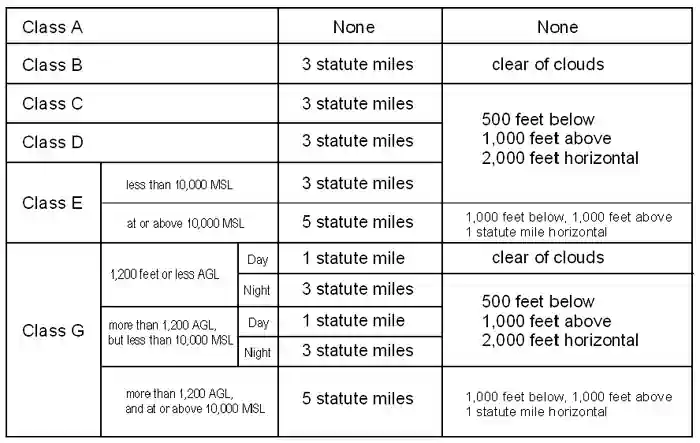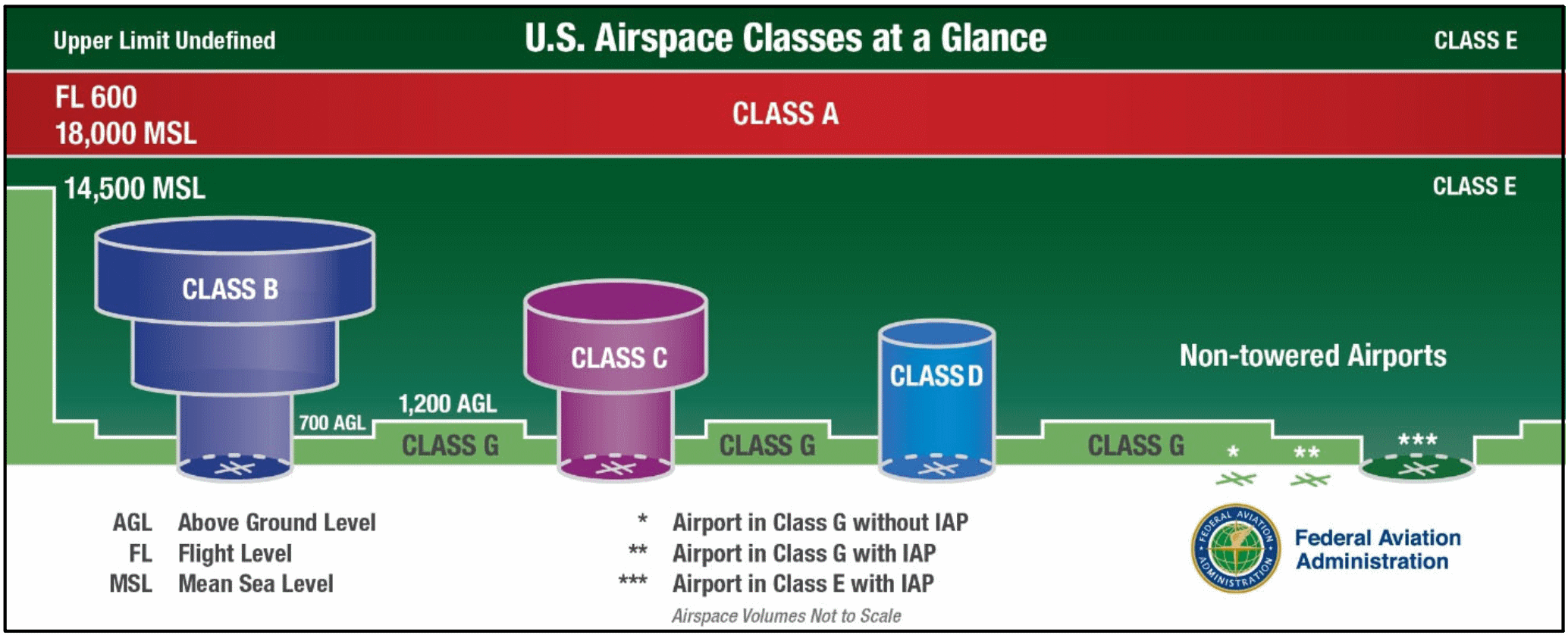class g airspace weather minimums
6 days ago 36 rows 91155 Basic VFR 36 rows 91155 Basic VFR. Yes it is possible to fly IFR in Class G airspace.
Clear of clouds Night.
. However pilots are required to meet IFR altitude and flight level requirements. Night - 3 Statute Miles. I am looking at the weather requirements for Class G operations and I cant seem to find an airport or airspace that would be Class G above 1200 feet.
Class G airspace is most easily found on a sectional map when a fading thick blue line appears. On a map Class Gs ceiling is the floor of Class E airspace. This is for your crop dusters your powered gliders and the uncontrolled airports around the country.
It is the most complex airspace for weather minimums as it not only has 3 altitudes it also has daynight minimums. Cloud Clearance Standard VFR Minima means 3 SM visibility 500 ft. VFR minimums at night below 10000 msl but higher than 1200 above the surface agl are.
Class G surface to 1200 ft Day. For example if Class E starts at 700 feet AGL Class G goes up to but doesnt include 700 feet AGL. To fly in Class G airspace you will need a minimum of a student pilot certificate.
A Unless otherwise specified in the certificate holders operations specifications when conducting VFR helicopter air ambulance operations in Class G airspace the weather minimums in the following table apply. This line shows enroute Class E airspace starting at. No person may operate an aircraft under basic VFR when the flight visibility is less or at a distance from clouds that is less than that prescribed for the corresponding altitude and class of airspace.
Class G 1200 to 10000 ft. Minimum flight visibility and distance from clouds. Consequently these aircraft do not.
Notwithstanding the provisions of paragraph a of this section the following operations may be conducted in Class G airspace below. The Flight Visibility minimums for both are. 1200 ft AGL or Below Day.
Class E is more restrictive than Class G airspace. And its always exclusive. These minimums cover most Class G airspace but are only valid during the daytime when you are within 1200 agl of the surface.
Class C airspace and Class D airspace are lumped together because the requirements are identical See Figure 4. 3 In Class G airspace IFR departures with visual transitions are authorized only after the pilot in command determines that the weather conditions at the departure point are at or above takeoff minimums depicted in a published departure procedure or VFR minimum ceilings and visibilities in accordance with 135609. Class G Is The Most Lenient And Confusing.
Visibility requirement 1 statute mile. Above 1200 feet AGL but below 10000 feet MSL during the day. Class G airspace uncontrolled is that portion of airspace that has not been designated as Class A Class B Class C Class D or Class E airspace.
Because of this requirement time spent. 135609 VFR ceiling and visibility requirements for Class G airspace. The requirements are slightly less restrictive in Class G airspace with a less restrictive daytime visibility below 10000 feet MSL 1 statute mile only and.
Here is what to know. 135609 VFR ceiling and visibility requirements for Class G airspace. I guess what I am asking is if there is an airport that is Class G at the surface outside of any other airspace where does the Class G end and where does the Class E begin.
Class G Uncontrolled Class G is considered uncontrolled airspace but still has VFR weather minimums. Depending on how high you fly and the time of day within Class G airspace your visibility requirement could range anywhere from 1SM to 5SM. When you understand that the minimums and the corresponding altitudes make sense.
3sm visibility 1000 above clouds 500 below clouds and at least 2000 horizontal from clouds. Visibility requirement 3 statute miles. See VFR Weather Minimums.
CFR US. 36 rows Notwithstanding the provisions of paragraph a of this section the following operations may be conducted in Class G airspace below 1200 feet above the surface. 36 rows 91155 Basic VFR weather minimums.
Cloud clearances range from clear of clouds to 1SM There are 6 sets of Class G weather minimums associated with various altitudes during the day or night. Basic VFR Weather Minimums. Distance from clouds requirement Clear of clouds.
14 CFR 91155 - Basic VFR weather minimums. Day - 1 Statute Mile. Above and 2000 ft.
Im Kenny Keller the creat. Rules governing VFR flight have been adopted to assist the pilot in meeting the responsibility to see and avoid other aircraft. Made in establishing the basic VFR weather minimums is that aircraft flying at lower altitudes ie below 10000 MSL andor in airspace with radar approach control andor an operating control tower ie Class B C and D airspace will be moving more slowly or that they will be under positive control.
The weather minimums in Class G airspace vary based on altitude whether it is day or night and proximity to an airport. 1200 ft AGL or Below Night. When flying into an airport in Class G airspace communications should be established prior to 4 NM from the airport up to and including 2500 AGL.
A helicopter may be operated clear of clouds in an airport traffic pattern within 12 mile of the runway or helipad of intended landing if the flight visibility is not. A Unless otherwise specified in the certificate holders operations specifications when conducting VFR helicopter air ambulance operations in Class G airspace the weather minimums in the following table apply. 14 CFR 91177 requires pilots to remain at least 1000ft above the highest obstacle within a horizontal distance of 4NM from the course indicated in the filed flight plan.
Basic VFR Weather Minimums The basic weather minimums required for you to fly VFR are stated in terms of flight visibility and distance from clouds horizontally and vertically. Cloud clearance minimums of 1000 feet above 1000 feet below and 2000 feet horizontally. 12 rows 3 Statute Miles.
Horizontal clearance of clouds. Class G will not be depicted on the charts. 10000 feet MSL or higher.
There are a few nuances here so pay attention. A Except as provided in paragraph b of this section and 91157. Class C Airspace Areas By State.
This is truly uncontrolled airspace.

Why Are There Mandatory Cloud Clearance Requirements Boldmethod
Regulations Vfr Minimums Learn To Fly Blog Asa Aviation Supplies Academics Inc
How To Remember Vfr Weather Minimums Bobbie Lind

Airspace Classes And Special Use Airspace Everything There Is To Know

Airspace Visibility Requirements Diagram Quizlet

Helicopter Instrument Procedures Part Three

This Is How Class G Airspace Works Boldmethod

Ifr Vs Vfr In Aviation Understanding The Differences Pilot Institute

Pa I E S1 Vfr Weather Minimums Youtube
What Are The Basic Vfr Minimums Quora

Faa Airspace For Vfr Flight Youtube
How To Remember Vfr Weather Minimums Bobbie Lind
How To Remember Vfr Weather Minimums Bobbie Lind
How To Remember Vfr Weather Minimums Bobbie Lind
Vfr Weather Minimums Cancel Ifr Darren Smith Flight Instructor Cfi Homepage


